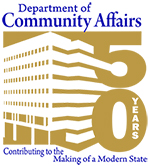![]()
1990: Melvin R. Primas Jr. appointed ninth commissioner of the Department of Community Affairs.
1990: NJ Supreme Court issues Holmdel decision, authorizing the municipal collection of development fees to fund fair share housing plans, charges COAH with developing standards.
1990: Housing, Codes and Standards and Community Resources split into three separate divisions.
1990: Division on Women establishes demonstration centers to provide job training programs and other services for Latino women.
1990: Radon Hazard Subcode is adopted.
1991: Local Government Ethics Law (NJSA 40A:11-22.1 et seq.) is enacted. Local Finance Board is required to hear ethics matters involving public officials and give advisory opinions on local government ethics matters. The Board must also enforce mandatory annual financial disclosure by local government officials.
1991: Congress establishes HOME Program and DCA administers the program in New Jersey. The program provides formula grants to states and localities to fund activities that build, buy, and/or rehabilitate affordable housing for rent or homeownership or provide direct rental assistance to low-income people.
June 1991: Office of Hispanic Affairs creates Latino Leaders Fellowship Institute to promote leadership and development of Latino college students.
Summer 1991: Office of Hispanic Affairs is renamed the Center for Hispanic Policy, Research and Development.
1991: Elevator Safety Subcode is adopted.
1992: Stephanie R. Bush appointed tenth commissioner of the Department of Community Affairs.
1992: Division on Women establishes the Office on the Prevention of Violence Against Women, which provides financial support and technical assistance to Sexual Violence Programs in all 21 counties. The Sexual Violence Programs provide free and confidential 24-hour crisis services for survivors, as well as prevention and education programs.
1992: Federal Lead Hazard Control Grant Program established.
1993: Bureau of Fire Safety becomes the Division of Fire Safety.
1993: Law establishing requirements for the licensing of those performing lead evaluation or abatement services is signed. Law also authorizes the Department to adopt work practice standards.
1994: Harriet E. Derman appointed eleventh commissioner of the Department of Community Affairs.
1994: Division of Housing and Division of Community Resources merge to form Division of Housing and Community Resources.
1994: Housing and Mortgage Finance Agency establishes first statewide scattered-site HIV/AIDS permanent housing program in the nation to provide 64 homes for individuals with HIV/AIDS and their families.
1994: COAH adopts second round rules and fair share housing obligations for 1987-1999.
1995: Main Street New Jersey Program joins Department of Community Affairs. The program helps municipalities improve the economy, appearance and image of their downtown business districts through the organization of local citizens and resources.
1995: Lead Hazard Evaluation and Abatement Code is adopted.
1996: Jane M. Kenny appointed twelfth commissioner of the Department of Community Affairs.
1996: Housing and Mortgage Finance Agency launches the Choices in Homeownership (CHOICE) Program. The program name has consistently been highly sought after, providing construction and subsidy funding for developers and attractive homebuyer loans.
1996: First annual Governor’s Conference on Women is held.
1996: HUD selects DCA for its Section 8 Sustained Performance Award for DCA’s exemplary performance in the day-to-day management of its Section 8 Program.
1997: Residential Site Improvement Standards are adopted.
1997: From 1997 to 2004, COAH reviews and certifies 245 second-round municipal housing elements and fair share plans.
May 31, 1998: New Jersey Redevelopment Authority (NJRA) transfers as independent authority from the Department of Commerce to the Department of Community Affairs. In 1998, the NJRA is appropriated $25 million to manage the New Jersey Urban Site Acquisition Program, which finances the redevelopment of underutilized parcels of land in the state’s urban areas.
1998: Housing and Mortgage Finance Agency establishes the Supportive Housing and Special Needs Division to improve housing for some of New Jersey’s most vulnerable citizens. The new division begins administering the Transitional Housing Revolving Loan Program to assist the homeless.
1998: Rehabilitation Subcode of the Uniform Construction Code is adopted. It is the nation’s first building code written just for existing buildings. The code makes it easier and cheaper to rehab older buildings, eliminating one of the leading obstacles to urban revitalization. The Rehabilitation Subcode garners national recognition and awards, including a 1999 Innovations in American Government Award presented by the Ford Foundation and Harvard University’s John F. Kennedy School of Government.
1998: Governor Whitman signs Reorganization Plan, transferring responsibility for carnival and amusement ride safety, ski lift safety, liquefied petroleum gas, lead contractor licensing and asbestos contractor licensing, and boilers, pressure vessels and refrigeration from the Department of Labor to the Department of Community Affairs. The same Reorganization Plan transfers responsibility for code enforcement in State buildings from the Department of Treasury to the Department of Community Affairs.
1999: Governor Whitman signs law creating a Thermal Imaging Camera Grant Program to equip every local fire department with at least one thermal imaging camera. New Jersey becomes first state in the nation to equip all its fire departments with this equipment, which provides an enormous advantage during search-and-rescue operations.
1999: DCA wins HUD Best Practices Award for its outstanding Section 8 Family Self-Sufficiency Program.
